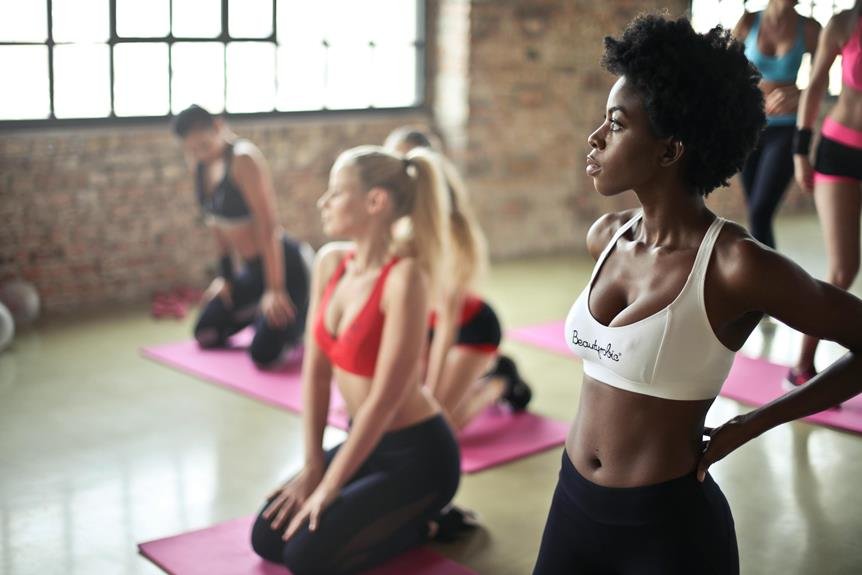How to Create a Sustainable Fitness Routine as You Age
As you navigate the journey of aging, your fitness routine can symbolize the resilience and adaptability of your body. Setting the groundwork for a sustainable approach to fitness involves more than just physical exertion; it encompasses a holistic view of well-being.
By understanding the nuances of incorporating strength training, flexibility, cardiovascular exercise, and proper rest, you can unlock the key to longevity and vitality. But how do you strike that delicate balance to ensure your fitness routine stands the test of time?
Setting Realistic Fitness Goals
When starting a sustainable fitness routine, set achievable goals that align with your current abilities and lifestyle. It's essential to be realistic about what you can accomplish to avoid burnout or injury. Begin by assessing your current fitness level and identifying areas where you want to improve. Whether it's increasing endurance, flexibility, or strength, choose specific goals that are measurable and attainable within a reasonable timeframe.
Consider factors such as your age, any existing health conditions, and time constraints when setting your fitness goals. It's crucial to tailor your objectives to fit your unique circumstances to increase the likelihood of success. Start with small milestones that you can build upon as you progress in your fitness journey.
Remember that consistency is key when working towards your fitness goals. Celebrate your achievements along the way, no matter how small they may seem. By setting realistic objectives and staying dedicated to your routine, you can establish a sustainable fitness plan that supports your overall well-being as you age.
Incorporating Strength Training
Looking to enhance your fitness routine as you age? Incorporating strength training into your workouts can be highly beneficial. As we get older, maintaining muscle mass and strength becomes increasingly important for overall health and functionality. Strength training not only helps you build muscle but also improves bone density, joint health, and metabolism.
To start incorporating strength training into your routine, consider using bodyweight exercises, resistance bands, or free weights. Aim for at least two to three days of strength training per week, focusing on all major muscle groups. Remember to start with lighter weights and gradually increase as you build strength to prevent injury.
Including exercises like squats, lunges, push-ups, and rows can help you target multiple muscle groups simultaneously. Additionally, don't forget to prioritize proper form over the amount of weight you lift. Consistency is key when it comes to strength training, so make sure to stick to your routine and gradually progress to more challenging exercises to continue seeing improvements in your strength and overall fitness levels.
Prioritizing Flexibility and Mobility
When it comes to maintaining your fitness routine as you age, prioritizing flexibility and mobility is key. Stretching regularly improves flexibility.
Joint mobility exercises keep you agile.
Working on balance enhances stability.
These aspects are fundamental for overall well-being and injury prevention as you navigate the aging process.
Stretching for Flexibility
To enhance your flexibility and mobility, prioritize incorporating regular stretching into your fitness routine. Stretching helps improve your range of motion, making daily activities easier as you age.
Focus on dynamic stretches before your workout to prepare your muscles and static stretches after to maintain flexibility. Aim for at least 10-15 minutes of stretching after each workout session. Hold each stretch for 15-30 seconds without bouncing, allowing your muscles to relax and lengthen.
Incorporating yoga or Pilates into your routine can also enhance flexibility and balance. Remember, consistency is key when it comes to improving flexibility, so make stretching a non-negotiable part of your fitness regimen to support your overall mobility and joint health.
Joint Mobility Exercises
Incorporate joint mobility exercises into your fitness routine to enhance flexibility and mobility as you age. These exercises focus on moving your joints through their full range of motion, helping maintain their health and flexibility.
Aim to include exercises that target different areas of your body, such as shoulder circles, leg swings, wrist rotations, and neck stretches. Performing these movements regularly can help improve joint lubrication, reduce stiffness, and prevent injuries.
Start with gentle movements and gradually increase the intensity as your flexibility improves. Remember, maintaining good joint mobility is crucial for staying active and independent as you grow older.
Prioritize these exercises in your routine to support your overall health and well-being.
Balance and Stability
Enhancing your balance and stability is essential for prioritizing flexibility and mobility as you age. Incorporating exercises that challenge your stability, such as single-leg stands, heel-to-toe walks, or balance board exercises, can help improve your overall balance.
By enhancing your stability, you create a solid foundation for better flexibility and mobility in your daily activities. Focus on strengthening your core muscles, including your abdominal and lower back muscles, as they play a crucial role in maintaining balance.
Additionally, practicing activities like yoga or tai chi can also aid in improving balance and stability while promoting flexibility. Prioritizing balance and stability in your fitness routine will contribute significantly to your overall well-being as you age.
Balancing Cardiovascular Exercise
Maintaining a balance between different types of cardiovascular exercise is key to optimizing your fitness routine as you age. Incorporating a mix of low-impact activities like walking, swimming, or cycling with higher intensity exercises such as running or aerobics can help improve your heart health, stamina, and overall fitness level.
To get the most out of your cardio workouts, aim for at least 150 minutes of moderate aerobic activity per week, or 75 minutes of vigorous exercise if your body allows it. Remember to start at a comfortable pace and gradually increase the intensity to avoid overexertion.
Switching up your routine regularly by trying different activities like dancing, hiking, or even playing sports can keep your workouts fun and engaging while challenging your cardiovascular system in new ways. Listen to your body to gauge how it responds to different exercises and adjust your routine accordingly to prevent injuries and ensure long-term sustainability.
Listening to Your Body
Listening to your body is crucial for effectively adapting your fitness routine to your changing needs as you age. Your body communicates with you, providing signals about what it needs. As you age, these signals become even more essential to pay attention to. If you feel persistent pain or discomfort during a particular exercise, it's your body's way of saying that something isn't right. Ignoring these signals can lead to injuries or setbacks. On the other hand, if you feel energized and strong after a workout, take note of what you did so you can incorporate more of that into your routine.
Tuning in to how your body responds to different types of exercise can help you tailor your fitness plan to suit your current capabilities. Maybe you used to love high-intensity workouts, but now find that gentler forms of exercise, like yoga or swimming, leave you feeling better overall. By listening to your body and adjusting your routine accordingly, you can ensure that you continue to stay active and healthy as you age.
Seeking Professional Guidance
When aiming to create a sustainable fitness routine, it's crucial to seek professional guidance.
Expert advice can help you navigate the complexities of aging and tailor a program that suits your needs.
Choosing the right trainer and having a skillfully designed program are key components for success in your fitness journey.
Expert Advice Importance
Wondering why seeking professional guidance is crucial when developing a sustainable fitness routine as you age?
Expert advice is essential because as we grow older, our bodies undergo changes that require specialized attention. Professionals, such as personal trainers or physiotherapists, can provide tailored workout plans that consider any existing health conditions, mobility limitations, or specific goals you may have.
They can offer insights on proper form, exercise intensity, and progression to prevent injuries and maximize results. Moreover, experts can keep you motivated, accountable, and ensure that you're engaging in activities that are safe and effective for your age group.
Trainer Selection Tips
Selecting the right trainer is a crucial step in developing a sustainable fitness routine that caters to your specific needs and goals as you age. When choosing a trainer, look for someone who specializes in working with older adults and understands the unique challenges that come with aging. Ensure the trainer is certified by reputable organizations and has experience in designing programs for mature individuals.
It's important to find a trainer who listens to your concerns, respects your limitations, and motivates you effectively. Before committing, schedule a consultation to discuss your fitness objectives, health history, and any existing conditions. A good trainer will personalize a workout plan that considers your age, fitness level, and long-term wellness goals.
Skillful Program Design
To ensure effective and safe progress in your fitness journey as you age, seeking professional guidance for skillful program design is essential. A fitness expert can tailor a program to your specific needs, considering any health concerns or limitations you may have. They'll evaluate your current fitness level, mobility, and goals to create a personalized plan that challenges you while minimizing the risk of injury.
With their expertise, you can benefit from a well-rounded routine that includes strength training, cardiovascular exercises, flexibility work, and proper rest days. Professional guidance not only enhances the effectiveness of your workouts but also provides accountability and motivation to help you stay consistent and make meaningful progress in your fitness journey.
Embracing Rest and Recovery
Incorporate regular rest and recovery periods into your fitness routine to optimize your overall well-being and physical performance. Rest isn't a sign of weakness but a crucial component of any successful fitness plan. When you push your body through exercise, it experiences stress that causes small tears in your muscles. These tears need time to repair and grow stronger, leading to muscle development.
Without adequate rest, your muscles may not have the opportunity to recover fully, increasing the risk of injury and overtraining.
Listen to your body's signals; if you feel excessively fatigued or notice persistent muscle soreness, it's time to prioritize rest. Incorporating active recovery days with light activities like yoga or walking can help maintain blood flow to your muscles without causing additional stress. Additionally, ensure you get quality sleep as it's during rest that your body produces essential hormones for recovery and repair.
Frequently Asked Questions
How Can I Maintain Motivation to Stick to My Fitness Routine as I Age?
You maintain motivation by setting realistic goals, mixing up your workouts, finding activities you enjoy, and celebrating small wins. Consistency is key, so listen to your body, adjust as needed, and remember the progress you've made.
Are There Any Specific Dietary Recommendations for Older Adults Looking to Improve Their Fitness?
As you age and strive to improve fitness, focus on a balanced diet. Incorporate lean proteins, whole grains, fruits, and vegetables. Stay hydrated and consider consulting a nutritionist for tailored guidance to support your fitness journey.
How Important Is It to Vary My Workouts as I Age, and How Can I Do so Effectively?
To maintain progress and prevent plateaus, varying workouts is crucial. Incorporate different exercises, intensities, and techniques. Try new activities like yoga, swimming, or hiking. Listen to your body and adjust as needed for a balanced routine.
What Are Some Common Misconceptions About Fitness for Older Adults That I Should Be Aware Of?
Be aware of misconceptions about fitness for older adults. Many believe aging means slowing down, but staying active is crucial. Quality over quantity matters; focus on functional movements and listen to your body.
How Can I Prevent Injury While Still Challenging Myself in My Fitness Routine?
Listen to your body's cues, gradually increase intensity, prioritize proper form, and include rest days. Pay attention to warning signs of overexertion and adjust your routine accordingly. Challenge yourself safely to prevent injury and maintain progress.
Conclusion
As you navigate the journey of aging and fitness, remember that Rome wasn't built in a day. It's like planting a seed and watching it grow; progress takes time and patience.
Keep tending to your body, nurturing it with strength, flexibility, and rest. Embrace the process, listen to your body's cues, and seek guidance when needed.
Your sustainable fitness routine is a journey, not a destination. Trust the process and enjoy the ride.






